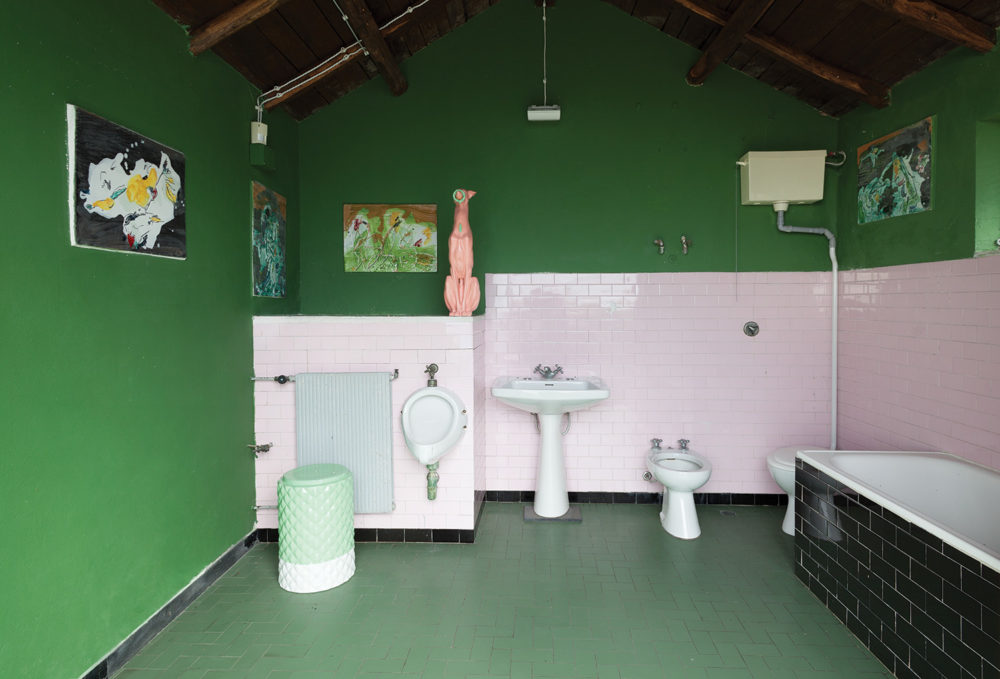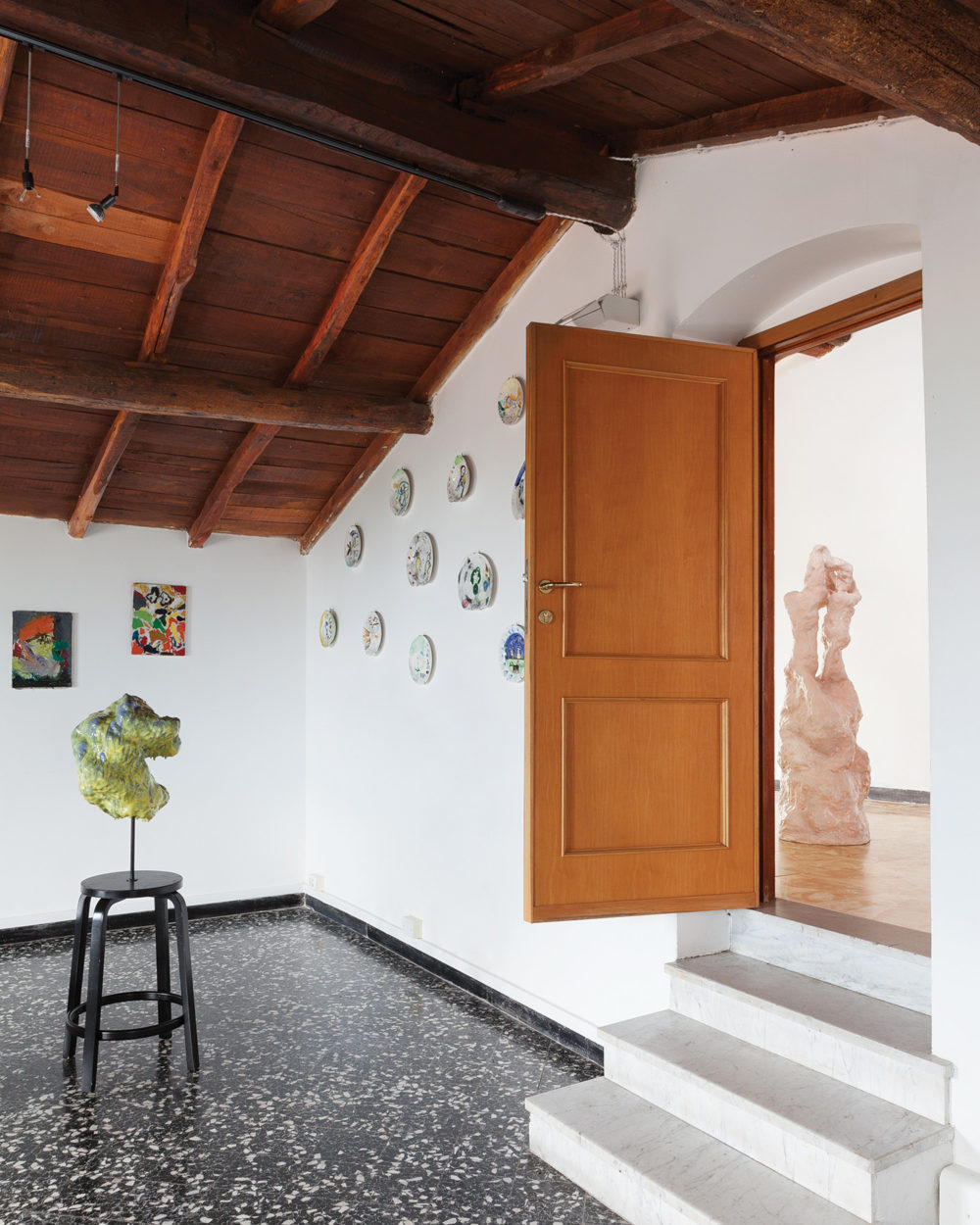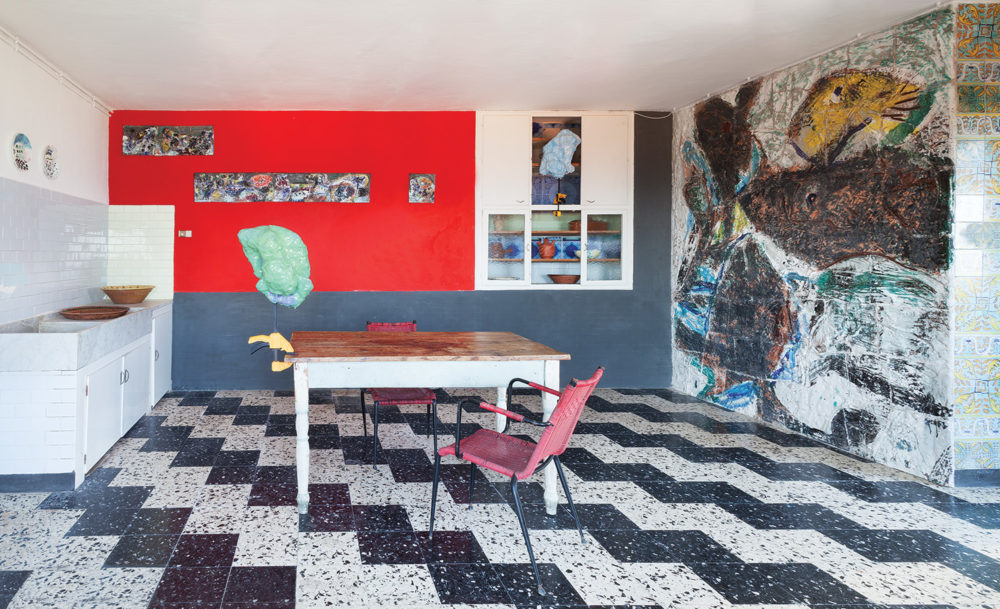The Annotated Asger Jorn
By Glenn Adamson
“It seems to fill my head with ideas – only I don’t exactly know what they are!” That’s Alice, through the looking-glass, where she discovers a book filled with backwards writing. Holding the pages up to a mirror, she is able to read the contents, a poem called “Jabberwocky.”
‘Twas brillig, and the slithy toves
did gyre and gimble in the wabe;
all mimsy were the borogroves,
and the mome raths, outgrabe…
In his inexhaustibly wonderful book The Annotated Alice, the mathematician Martin Gardner provided extensive commentary on Lewis Carroll’s masterworks. His notes on “Jabberwocky” are typically informative. He gives translations of the poem into French and German, and records Carroll’s half-jesting definitions for the made-up words: TOVE. A species of Badger. They had smooth white hair, long hind legs, and short horns like a stag; lived chiefly on cheese. Along the way, Gardner offers some thoughts on the nature of nonsense. “There is an obvious similarity,” he writes, “between nonsense verse of this sort and an abstract painting.” While the realist artist and poet alike must abide by external realities, the abstract painter and the writer of nonsense are free. Their creations may “suggest vague meanings, like an eye here and a foot there in a Picasso abstraction, or they may have no meaning at all.”1
It is in this spirit that we might understand Anders Ruhwald’s artistic response to Asger Jorn – a project that Ruhwald himself describes as a “series of annotations.” Think of these sculptures, introduced within the rooms and around the grounds of Jorn’s residence in Albissola, as something like Gardner’s elaborate footnotes. They deepen our encounter with an elusive figure, without ever trying to pin him down. Attempting to actually make sense of Carroll’s books, or Jorn’s gesamtkunstwerk, with their many aesthetic layers, to say what they “mean,” would be a travesty. Marking out new paths through a wonderland, though – that is another matter. For, as the Red Queen put it, “It’s a poor sort of memory that only works backwards.”
Jorn and Ruhwald were born about sixty years and twenty miles apart, in the towns of Vejrum and Randers, respectively, in the northern part of Denmark. It’s a rustic part of the world, and traditionally, a religious one. Jorn was raised a devout Christian there. Though he later repudiated the faith, it remained central to his life; at one stage, as part of his investigations into primitivism, he collected many thousands of photographs for an archive of Nordic art, concentrating particularly on medieval stave churches. In a broader sense, too, the question of symbolism consumed his intellectual energies. He was fascinated by the communicative potency of the pictorial sign – which would have included the crucifix he was obliged to worship as a boy – but also concerned about the use and abuse of that power. In his important 1962 essay, entitled “Neither Abstraction Nor Symbol,” Jorn tried to stake out a middle position, not wholly non-objective, nor dogmatic, but instead suggestive. He cited an experiment he had conducted with a group of painters, in which he made a scribble and laid tracing paper over it, asking each artist to highlight the part of the drawing that seemed to them most important. Each chose a different passage in the drawing, a result that for Jorn proved the inherent ambiguity of the artistic sign.2

Fig. 1
This was the same phenomenon that Alice confronted in “Jabberwocky” – the way that a language can teeter at the precipice of legibility, without quite tipping into it. It’s a concern that has been intrinsic to Ruhwald’s practice, too. Long before his engagement with Jorn, he was creating sculptures that could be read as figurative, as purposefully undefined, or as indexical records of process, all depending on one’s perspective. In his 2014 exhibition The View From the Sides of My Nose, Ruhwald presented pairs of objects – two columns, two clay masses on tall stands, two priapic totems, two Google “you are here” pins, and so on. Each set, like Tweedledum and Tweedledee, was just slightly different – in texture, material, color, or handling. One could imagine magic spectacles, like the 3D eyeglasses handed out at the cinema, which would have made each pair resolve into a single impossible object. The show made palpable the relativistic nature of looking, much like the famous color studies of Josef Albers, but in sculptural and expressive dimensions.
For the Albissola project, Ruhwald has taken a related approach. In Four Sailors, for example, he disaggregates the morphology of a human head – eye, nose, ear, mouth – and positions them throughout the Casa Jorn gardens. In part, this was simply an attempt to reinhabit the grounds. Ruhwald was struck by the nostalgia still clings to the site: “People who knew Jorn and visited the house when it was still lived in express a natural disappointment with the place as it is now, not having him there – or his several wives, kids, goats or friends.” The Four Sailors restore a sense of welcoming presence. Yet they are only vaguely anthropomorphic, and cannot be assembled into a holistic form, except in the mind’s eye. Appealing to the visitor’s constructive imagination in this way, Ruhwald invites the associative response that was so important to Jorn – what he had called “ambiguities in artistic decipherment.”3
It is unsurprising that Ruhwald chose to activate the gardens with a group of guardians, for liminal space is another of his preoccupations – and one that he again shares with Jorn. Though just as committed to radical change as his fellow avant gardistes in CoBrA and the Situationist International, Jorn was primarily interested in how change actually occurs, both in art and in history. This led him down some strange rabbit holes – including his obsession with “triolectics” (like dialectics, but operating through structures of three opposing terms) – but also remarkable instances of clarity, as when he wrote: “Between question and answer there is a delay, the duration of which is the present itself.”4

Fig. 2
Jorn was here adapting the widely known Situationist concept of dérive, or “drift,” in which time is spent in intentional aimlessness, in order to cultivate chance discovery. This principle characterizes all of Ruhwald’s interventions at Albissola. One encounters them throughout the property, around corners, on steps, perched on edges of things. Dérive is particularly important to a trio of works that he has positioned in Jorn’s studio, each titled Old Man, and having the approximate scale and stance of a person. Their head-like appendages are propped up on steel rods, which wander hither and thither on their journey upwards from the floor. It is easy to see the three sculptures as variant pseudo-portraits of Jorn himself, perhaps even a nod to his interest in triolectics. Easy, too, to understand them as diagrammatic of Jorn’s geographically digressive biography, which took him from Copenhagen to Paris, and eventually to Albissola – “the village where the Italian futurists had already roamed,” as Ruhwald notes.
Elsewhere in the house, in Jorn’s bedroom, is what appears to be a sunset-lit cloud, captured and brought down to earth. Entitled Pillar, it too could be taken as a portrait, perhaps showing the artist’s interior mental landscape. Ruhwald has taken advantage of clay’s inherent formlessness, using it to materialize the open-ended feeling of dream images – another sort of conceptual drift. It is a motif that recurs throughout the project, in works that Ruhwald has collectively titled Adaptable Body. That phrase refers, one again, to figuration, but also to his own craft: the clay body and its infinite possible forms. Each sculpture in the series features a glazed blob propped up on a shaft. Two of the amorphous shapes are connected to store-bought clamps, an image of extreme contingency – they can be detached and reattached at will – and another pair features Alvar Aalto stools, which are repurposed as plinths (an obvious allusion to Duchamp’s Bicycle Wheel). As in the compact and graphically powerful sculpture This Constructed World – in which a Poul Henningsen PH lamp is caught fast in a mass of clay – these latter works juxtapose diametrically opposed modes of Nordic modernity: design icons, meet the avant garde. Ruhwald has bestowed the additional title of La Dolce Vita on the “assisted” Aaltos, prompting thoughts of Federico Fellini’s filmic satyricon of 1960, but also referring to a work of that title by Jorn, painted right on top of a found amateur painting.
These so-called “décollages” or “modifications” were perhaps Jorn’s most prescient works, anticipating postmodernism, and they are quite close to Ruhwald’s own working method. Like Jorn, he has his issues with functionalist modernism. He draws heavily on its aesthetic codes, and general formal rigor, but always splices those traits with contradictory ones. Two further works in Ruhwald’s show apply this hybrid approach to very different ends. Construction of a Rainbow, located in the children’s bedroom, is a sculptural extrapolation from Bauhaus-style color and form experiments, disarmingly reimagined as a giant ring toss game. Dog Whistle incorporates two elements, both sourced in Detroit: the Vietnamese-style flowerpot is from a strip mall, and the greyhound is from “Ceramics By Bob & Hazel,” an extraordinary shop in Pontiac, Michigan, which offers slipcast objects of every description. It’s a gold mine of kitsch. Ruhwald simply joined these two found objects together, glazed them, and in an inspired comic touch, popped a ring over the dog’s snout. It sits in perpetual high alert, yet seems aware of its own ridiculousness.

Fig. 3
This witty appropriation of “low” industrial ceramics does have a specific correlate in Jorn’s practice – for his house, he sourced tiles and electrical parts from local Albissola factories, repurposing them within his own ambitious decorative scheme. But there is also a broader theme at issue, here, to do with one of Jorn’s most important ideas: the vibrancy of the commonplace. In his early essay “Intimate Banalities” (1941), part manifesto and part fairy tale, he railed against deadly good taste, and expressed his preference for the hackneyed. In one beautiful passage, he describes his “greatest musical experience,” which supposedly occurred in a provincial village. Jorn claims that the local people were seized by a sudden and inexplicable enthusiasm for playing small plastic whistles, such that the town was filled with the sound: “Every boy, every girl, men and women, even elderly honourable citizens would secretly carry the small pan pipes in their pockets, taking it out when they believed themselves unobserved to drink in a few warbles of this captivating wonder.”5
It is probably a coincidence that Ruhwald found room for a Dog Whistle in his project – and, as we know, that particular instrument can’t be heard by human ears. All the same, it is easy to imagine, drifting over the space of Casa Jorn, the tuneless chirping of his parable of a village brought to life. In a space filled with aesthetic departures – “a maze of continually intersecting strains of narratives, people and ideas complicated by the passage of time,” in Ruhwald’s words – he has introduced further tangents, leading both back to Jorn, and forward into the ever-expanding possibilities of sculpture. The house was already a cabinet of curiosities, a hall of wonders, a total environment, a stratigraphy of ideas. And with Ruhwald’s annotations? Well, Alice put it best: curiouser and curiouser…
1 Martin Gardner, ed., The Annotated Alice: The Definitive Edition (New York: W. W. Norton, 2000 [orig. 1960]), p. 159.
2 Asger Jorn, “Neither Abstraction Nor Symbol,” in Henri Michaux (Silkeborg, Denmark: Silkeborg Museum, 1962). In this essay, Jorn also offhandedly predicted the rise of our current infotainment industry: “When one sees the colossal spread of the modern strip cartoon, one wonders why newspapers do not formulate their news in the same way. But perhaps that will come.”
3 Jorn, “Neither Abstraction Nor Symbol.”
4 Asger Jorn, “On the Triolectical Method in its Applications in General Situlogy” (1964), in Mikkel Bolt Rasmussen and Jakob Jakobsen, eds, Cosmonauts of the Future: Texts from The Situationist Movement in Scandinavia and Elsewhere (Copenhagen: Nebula, 2015), p. 264.
5 Asger Jorn, “Intimate Banalities,” first published in Helhesten 1/2 (1941), p. 33-38; trans. René Lauritsen.
Figure 1-3. Anders Ruhwald, The Body, The Mind, This Constructed World, 2018, curated by Luca Bochicchio at Casa Museo Jorn in Albissola, Italy, Installation view. Photography by Paolo Riolzi.
Glenn Adamson is a curator, writer and historian based in Brooklyn, who works across the fields of design, craft and contemporary art.
©2019 Glenn Adamson, for The Body, The Mind, This Constructed World by Anders Ruhwald, curated by Luca Bochicchio at Casa Museo Jorn in Albissola, Italy.

